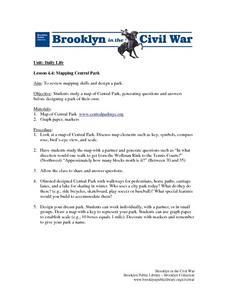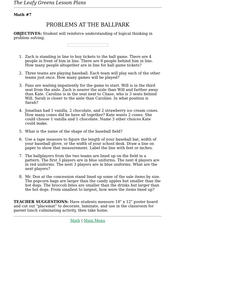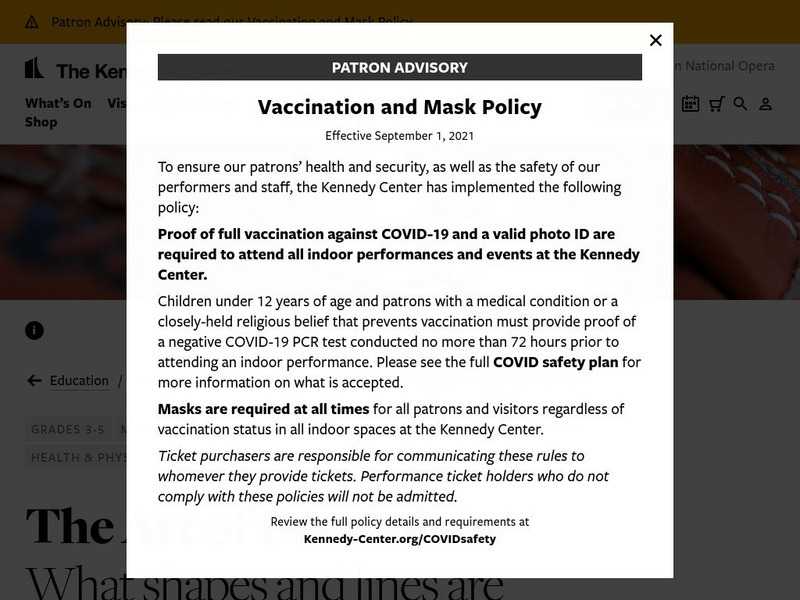Curated OER
Mapping Central Park
Students use the mapping skills to explore New York's Central Park. They examine a map of Central Park to discover its features. After discussing the characteristics of the park, students design their own dream park and draw it to scale.
Curated OER
Costume Choices
In this probability worksheet, 6th graders create as many different costume combinations as they can based on the information they are given.
Curated OER
Two Variable Inequalities
In this algebra worksheet, students solve inequalities using addition, subtractions and multiplication. They graph the inequalities with shading. There are 2 questions.
Curated OER
Use Doubles to Add
In this adding with doubles activity, students read the word problems and use the addition property of doubles to help them solve the addition problems.
Curated OER
Problems at the Ballpark
Seventh graders reinforce understanding of logical thinking in problem solving.
Curated OER
Create and Solve
In this number sentences instructional activity, students practice adding the single digit numbers and comparing the given numbers by creating number sentences and solve the addition problems.
Curated OER
The Shortest Distance
Students, working on their GED, examine the steps used to resolve the unknown sides of a right triangle. They express the square root function as an exponential function and derive the distance formula using principles of geometry.
Curated OER
Nonprofit and Profit Careers
Students examine the difference between profit and nonprofit organizations. They identify careers that are available in each sector as well. They develop their own questions and interview people who are in those careers.
Curated OER
Looking at Data
Third graders use two days to create, collect, display and analyze data. Classroom activities and practice build greater understanding to a variety of forms used to display data.
Curated OER
Less vs. Fewer
When should you use less, and when should you use fewer? Straighten out this dilemma with a helpful resource about using less vs. fewer based on sentence context clues. After reading detailed instructions and examples, young learners...
Curated OER
Motion Capture and Analysis
Pupils capture the serve motion of a tennis player with a digital or video camera. Using transparencies or a software package, analyze the speed, acceleration, displacement and time of the racquet head and ball in the tennis stroke.
Curated OER
Collisions and Momentum: Bouncing Balls
Middle schoolers explore the concepts of potential and kinetic energy by bouncing assorted balls on different surfaces and calculating the momentum for each ball. They give examples of collisions and momentum in sports and understand...
Curated OER
The Berenstain Bears' Mad, Mad, Mad Toy Craze
Young scholars use the book, The Berenstain Bears' Mad, Mad, Mad Toy Craze, to explore spending, collecting, opportunity cost, saving, and speculating.
Curated OER
Agriculture Counts
Students discuss ways in which agriculture impacts their lives on a daily basis. In groups, they brainstorm ideas that they could possibly write about. They write a rough draft, participate in peer editing and write a final draft of a...
Curated OER
Bouncing Balls
Middle schoolers work together to examine how different types of balls react to colliding with different surfaces. They discover the difference between elastic and inelastic collisions. They practice calculating momentum as well.
Curated OER
Couch Potato or Inertia Victim?
Sixth graders how primary research is carried out. They design a simple survey questionnaire to interview people about their week average television watching time. They analyze the results and write a report based on the information.
Scholastic
Scholastic: Baseball Math
Learn more about baseball and math when you check out this resource. It provides a lesson plan for upper elementary to middle school middle schoolers where they will use their skills in percentages, decimals and combinations.
John F. Kennedy Center
The Kennedy Center: All Around the Baseball Field
Here's a lesson plan that combines art, music, movement, critical thinking, math, and baseball. The plan gives complete instructions, printable resources and web links, assessment, and application of national standards.
Other
Web Quest: Take Me Out to the Ball Game
This is a WebQuest written by Susie Hallar of the Warrensburg Schools in Warrensburg, Missouri. Students research 10 famous baseball players, then use the information they find to compute averages, standard deviations, central...
Alabama Learning Exchange
Alex: The Mean, Median, and Mode Chain Gang
Cooperative learning groups and chain links are used to find the mean, median, and mode. A Science NetLinks lesson is linked for further real-life application in the world of baseball (optional). This lesson plan was created as a result...





















